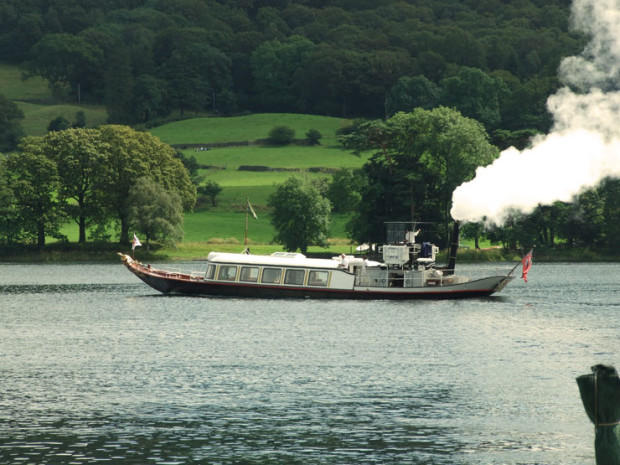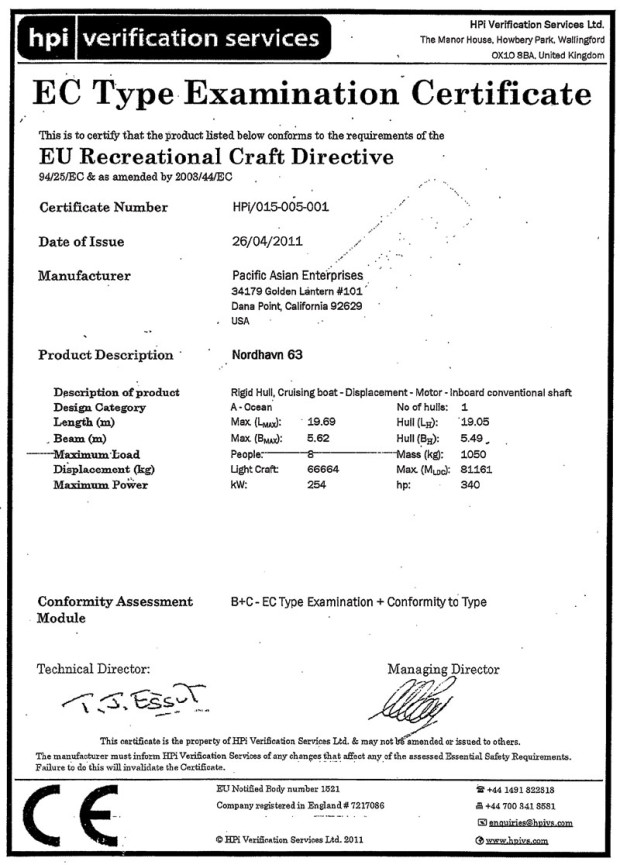Boat builders from everywhere have to respect certain building and security standards. They must get a handle on all the different boat building standards, rules and regulations that were ever produced. Most countries subscribe to some published set of guidelines, codes or laws that a boat builder must follow in order to sell a boat in that country. Fortunately, there is parity between many of the different international regulatory bodies that create these standards, so in most cases there are more similarities than differences.
[source: stockpics]
There are great differences between building in USA and European Union, and I’m not talking of the standards, but of the procedures. In USA, it’s up to the builder to voluntarily comply with the published guidance – which is certainly in a builder’s interest to do. In the European Union, by law, a boat has to be inspected, documented and certified that it meets the published guidance.
In U.S., the government in the has left it up to private industry to create a body of guidance for building safe recreational boats. You can download every set of requirements from ABYC (American Boat and Yacht Council) and you, as a builder will comply with their rules.
There is no such thing as an “ABYC Certified” boat – and ABYC does not employ boat inspectors who verify that builders are following its standards.
On the other side, in European Union, by law a boat has to be inspected, documented and certified that it meets the published guidance. This understandably adds to the cost of the boat in terms of hiring outside inspectors and creating documentation. There is also an additional level of scrutiny for any boat where a pleasure yacht or commercial charter yacht classification is desired, which involves ongoing inspections throughout the build, extensive documentation and the use of materials and equipment that is held to a certain standard.
Do not mistake classification with certification. One needs a Certificate only in the EU, in order to use the boat in EU waters. So, if you buy a boat in Turkey, and you want to use it in Monte Carlo, you need to have it inspected and certified with something like below:
In Italy, they have RINA (Registro Italiano Navale) to certify the boats with Italian flag, in UK and their dominions, they have MCA Code of Practice, which is a set of rules that applies only to the UK and other “Red Flag” UK overseas territories (Bermuda, Cayman Islands, Gibraltar, Isle of Man, etc.), and in the whole UE, including Italy and UK, by the way, they have Recreational Craft Directive – RCD, adopted in 1996. Australia and New Zealand have published their own set of rules with regard to electrical installations on boats. The most recent version is AS/NZS 3004.2:2008, very close to ABYC regulations, so there can be minimum modifications to make for a boat built in USA to be operated in Aussie waters.
The main organisms for boat classification in the world, are ABS (American Bureau of Shipping), Lloyd’s Register and Bureau Veritas. Believe me, they don’t bother with boats less than 79 feet LOA (24 meters), so if you’ll ever see specified by a broker that such and such “unlimited classifications” exist, don’t believe it.
You may ask yourself what exactly is a CE class on the boat specifications. It is a four type classification (A, B, C, and D), which determines where you can navigate your boat.
This goes hand in hand with the Beaufort Scale, a wind classification chart, which you have below.
Modern Beaufort Scale
| Beaufort number | Description | Wind speed | Wave height | Sea conditions | Land conditions | ||
| 0 | Calm | < 1.1 km/h | 0 m | Flat. | Calm. Smoke rises vertically. | ||
| < 0.7 mph | |||||||
| < 0.6 knot | 0 ft | ||||||
| < 0.3 m/s | |||||||
| 1 | Light air | 1.1–5.5 km/h | 0–0.2 m | Ripples without crests. | Smoke drift indicates wind direction. Leaves and wind vanes are stationary. | ||
| 0.7–3.4 mph | |||||||
| 0.6–3 knot | 0–1 ft | ||||||
| 0.3–1.5 m/s | |||||||
| 2 | Light breeze | 5.5–11.9 km/h | 0.2–0.5 m | Small wavelets. Crests of glassy appearance, not breaking | Wind felt on exposed skin. Leaves rustle. Wind vanes begin to move. | ||
| 3.4–7.4 mph | |||||||
| 3–6.4 knot | 1–2 ft | ||||||
| 1.5–3.3 m/s | |||||||
| 3 | Gentle breeze | 11.9–19.7 km/h | 0.5–1 m | Large wavelets. Crests begin to break; scattered whitecaps | Leaves and small twigs constantly moving, light flags extended. | ||
| 7.4–12.2 mph | |||||||
| 6.4–10.6 knot | 2–3.5 ft | ||||||
| 3.3–5.5 m/s | |||||||
| 4 | Moderate breeze | 19.7–28.7 km/h | 1–2 m | Small waves with breaking crests. Fairly frequent whitecaps. | Dust and loose paper raised. Small branches begin to move. | ||
| 12.2–17.9 mph | |||||||
| 10.6–15.5 knot | 3.5–6 ft | ||||||
| 5.5–8 m/s | |||||||
| 5 | Fresh breeze | 28.7–38.8 km/h | 2–3 m | Moderate waves of some length. Many whitecaps. Small amounts of spray. | Branches of a moderate size move. Small trees in leaf begin to sway. | ||
| 17.9–24.1 mph | |||||||
| 15.5–21 knot | 6–9 ft | ||||||
| 8–10.8 m/s | |||||||
| 6 | Strong breeze | 38.8–49.9 km/h | 3–4 m | Long waves begin to form. White foam crests are very frequent. Some airborne spray is present. | Large branches in motion. Whistling heard in overhead wires. Umbrella use becomes difficult. Empty plastic bins tip over. | ||
| 24.1–31 mph | |||||||
| 21–26.9 knot | 9–13 ft | ||||||
| 10.8–13.9 m/s | |||||||
| 7 | High wind, moderate gale, near gale |
49.9–61.8 km/h | 4–5.5 m | Sea heaps up. Some foam from breaking waves is blown into streaks along wind direction. Moderate amounts of airborne spray. | Whole trees in motion. Effort needed to walk against the wind. | ||
| 31–38.4 mph | |||||||
| 26.9–33.4 knot | 13–19 ft | ||||||
| 13.9–17.2 m/s | |||||||
| 8 | Gale, fresh gale |
61.8–74.6 km/h | 5.5–7.5 m | Moderately high waves with breaking crests forming spindrift. Well-marked streaks of foam are blown along wind direction. Considerable airborne spray. | Some twigs broken from trees. Cars veer on road. Progress on foot is seriously impeded. | ||
| 38.4–46.3 mph | |||||||
| 33.4–40.3 knot | 18–25 ft | ||||||
| 17.2–20.7 m/s | |||||||
| 9 | Strong gale | 74.6–88.1 km/h | 7–10 m | High waves whose crests sometimes roll over. Dense foam is blown along wind direction. Large amounts of airborne spray may begin to reduce visibility. | Some branches break off trees, and some small trees blow over. Construction/temporary signs and barricades blow over. | ||
| 46.3-54.8 mph | |||||||
| 40.3–47.6 knot | 23–32 ft | ||||||
| 20.7–24.5 m/s | |||||||
| 10 | Storm, whole gale |
88.1–102.4 km/h | 9–12.5 m | Very high waves with overhanging crests. Large patches of foam from wave crests give the sea a white appearance. Considerable tumbling of waves with heavy impact. Large amounts of airborne spray reduce visibility. | Trees are broken off or uprooted, structural damage likely. | ||
| 54.8–63.6 mph | |||||||
| 47.6–55.3 knot | 29–41 ft | ||||||
| 24.5–28.4 m/s | |||||||
| 11 | Violent storm | 102.4–117.4 km/h | 11.5–16 m | Exceptionally high waves. Very large patches of foam, driven before the wind, cover much of the sea surface. Very large amounts of airborne spray severely reduce visibility. | Widespread vegetation and structural damage likely. | ||
| 63.6–72.9 mph | |||||||
| 55.3–63.4 knot | 37–52 ft | ||||||
| 28.4–32.6 m/s | |||||||
| 12 | Hurricane force | ≥ 117.4 km/h | ≥ 14 m | Huge waves. Sea is completely white with foam and spray. Air is filled with driving spray, greatly reducing visibility. | Severe widespread damage to vegetation and structures. Debris and unsecured objects are hurled about. | ||
| ≥ 72.9 mph | |||||||
| ≥ 63.4 knot | ≥ 46 ft | ||||||
| ≥ 32.6 m/s |
This chart is from Wikipedia.org.
The CE class A, means that the boat can navigate the ocean, can surpass a wind force of 8 on Beaufort scale, and waves even higher than four meters.
Class B means that the vessel can navigate just in offshore waters (maximum 200 miles), can support winds up to force 8 on Beaufort scale, and waves up to four meters high.
It seems obvious that Class C is for even smaller boats (or if not small, less gifted by their builders). They are recommended to navigate inshore such as on lakes, rivers, bays and close to the shore and can sustain winds up to force 6 and waves up to two meters.
In the end, Class D boats, are for in shore waters without waves higher than half a meter and with a wind force of maximum 4.
If you like what you read, please subscribe to this blog by completing the form. If you want to help more, start by following us on Twitter, and like our page on Facebook. You don’t know what good things may happen. To lighten your day, check our pins on Pinterest, we can be friends there too. Oh, and if you need a really good looking blog attached to your site, or just for fun, to express your feelings more competitively, read this Own Your Website offer! Thank you very much.
Copyright © 2015 The Yacht Owner – Regulations, Classification and Certificates


